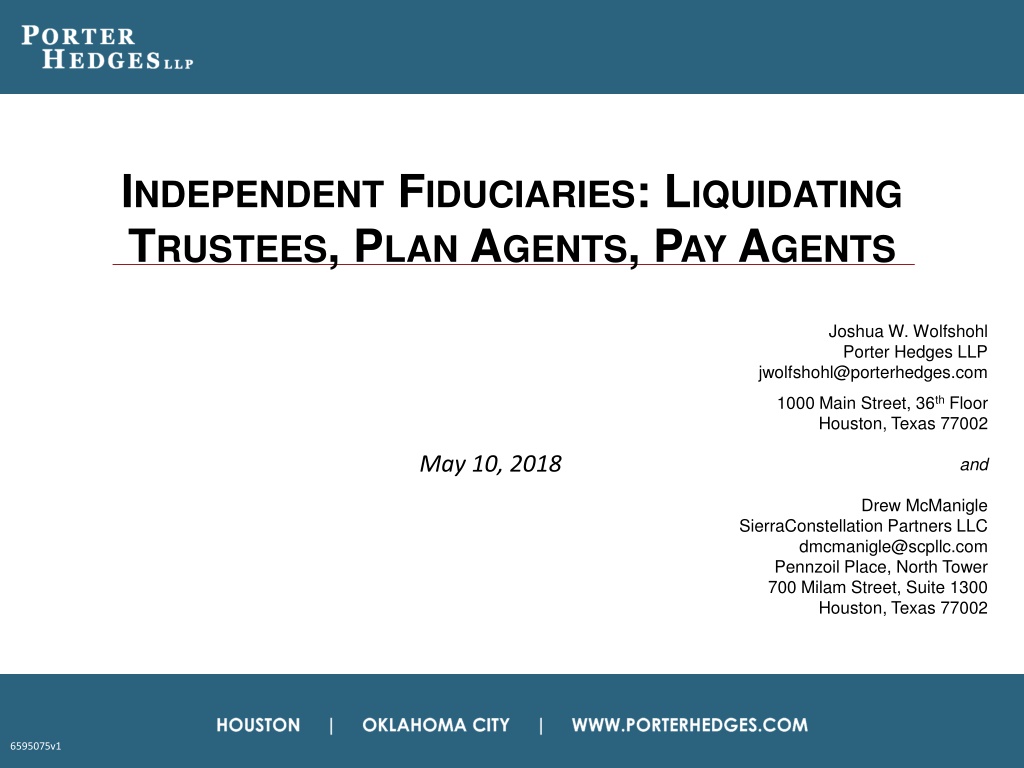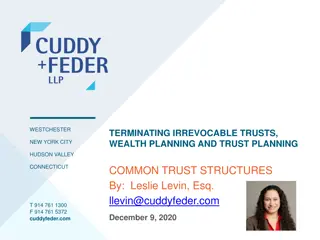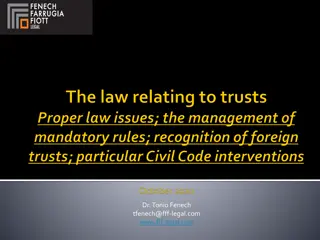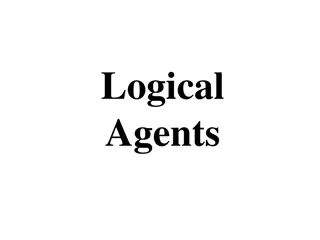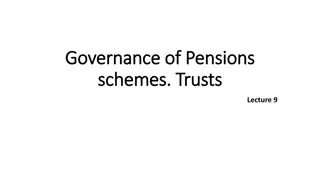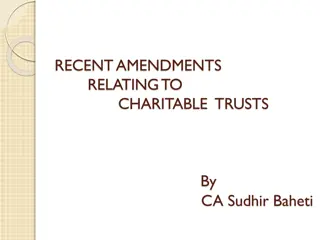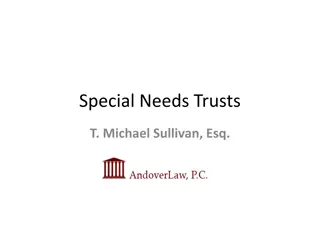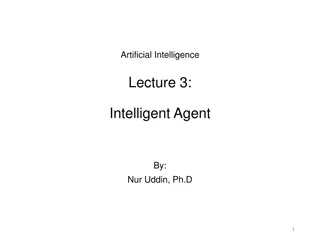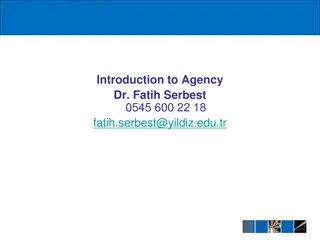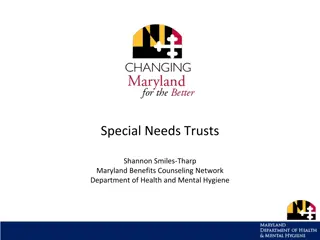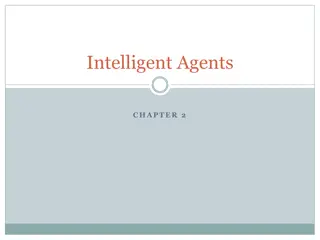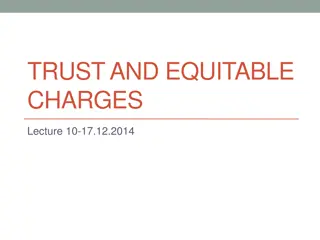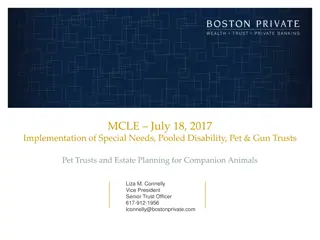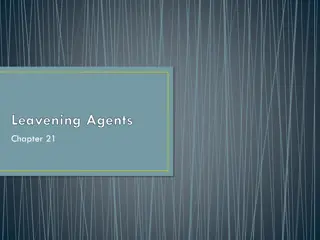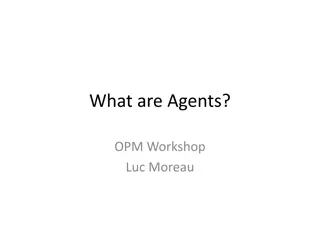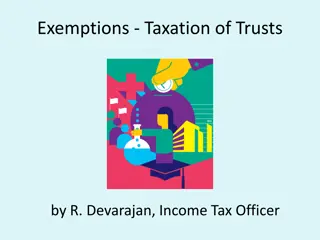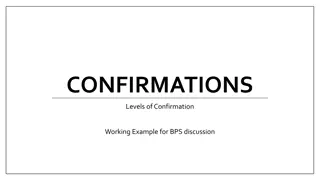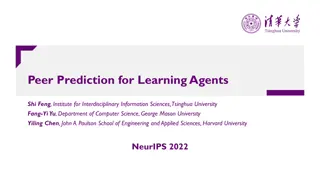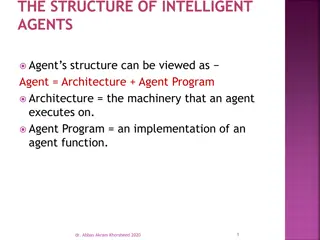Comprehensive Guide to Post-Confirmation Trusts and Plan Agents
Learn about the importance and necessity of post-confirmation trusts and plan agents in bankruptcy cases, the selection process for trustees/fiduciaries, choosing the right post-confirmation vehicle, creating trusts through agreements, and understanding the role of litigation/liquidation trusts in managing bankruptcy estates effectively.
Download Presentation

Please find below an Image/Link to download the presentation.
The content on the website is provided AS IS for your information and personal use only. It may not be sold, licensed, or shared on other websites without obtaining consent from the author. Download presentation by click this link. If you encounter any issues during the download, it is possible that the publisher has removed the file from their server.
E N D
Presentation Transcript
INDEPENDENT FIDUCIARIES: LIQUIDATING TRUSTEES, PLAN AGENTS, PAY AGENTS Joshua W. Wolfshohl Porter Hedges LLP jwolfshohl@porterhedges.com 1000 Main Street, 36th Floor Houston, Texas 77002 May 10, 2018 and Drew McManigle SierraConstellation Partners LLC dmcmanigle@scpllc.com Pennzoil Place, North Tower 700 Milam Street, Suite 1300 Houston, Texas 77002 6595075v1
WHYARE POST-CONFIRMATION TRUSTS/PLAN AGENTS NEEDED? Allows a bankruptcy estate to end its existence, and as a result, the Debtor loses its status as a debtor-in-possession. However, the bankruptcy case remains open until a final decree is entered, which provides for continuing Bankruptcy Court jurisdiction. Provides a mechanism by which the Debtor's creditors can maximize their recovery by liquidating Debtor's assets and causes of action, and minimize costs associated with Bankruptcy Court oversight approval of that process. 2
SELECTIONOF PLAN TRUSTEE/FIDUCIARY Selection of a Plan Trustee/Fiduciary Who decides? Debtor, UCC, UST, Judge? Who can serve? Prior trustee experience necessary? Need to be on UST s chapter 7 trustee panel? Bonding Requirements Approval of Selection in Chapter 11 Plan/Confirmation Order Deciding on the Right Person Prior post-confirmation trustee/plan agent experience Prior involvement in the case Other considerations o What is the trustee s/fiduciary s role in the case? Litigation, wind down of business, P&A, environmental issues, sell assets, claims administration 3
CHOOSINGA POST-CONFIRMATION VEHICLE What is the best post-confirmation vehicle to use? Most Common Post-Confirmation Trusts Litigation Trusts Liquidation Trusts Environmental Clean-Up/P&A Trusts Some combination of the above Also Used Plan Agent Pay Agent Plan Administrator Distribution Agent 4
HOW ARE TRUSTS CREATED? Trusts are created by contract Created by an agreement between creditors and other parties-in-interest, usually through a confirmed Chapter 11 Plan A confirmed plan is not the only way a Trust can be created: Structured Dismissals Settlement Agreements 5
WHATISA POST-CONFIRMATION LITIGATION/LIQUIDATION TRUST? Trusts are separate and distinct legal entities and are created for the benefit of a Debtor's creditors to prosecute certain causes of action and/or liquidate assets that are transferred to the Trust, usually as a result of a Debtor's confirmed plan. The creation of Trusts are authorized under section 1123(b)(3)(B) ".. a plan may provide for the retention and enforcement by the debtor, by the trustee, or by a representative of the estate appointed for such purpose, of any such claim or interest..." The ultimate goal is to make pro-rata distributions to the Trust beneficiaries (holders of claims against the pre-confirmation Debtor) 6
WHATARESOMEKEYPROVISIONSTHATNEEDTO BECONSIDEREDWHENCREATINGA TRUST? Most Trusts (almost all) are considered Grantor Trusts (Treasury Regulation 301.7701-4(d) and Revenue Procedure 94-45). Debtor/Estate Assets Creditors Trust o Assets are transferred first to Creditors, then into the Trust o Creditors become owners/beneficiaries of the Trust As a result, the Trust does not generate its own tax liabilities and the Trust is enabled to make pro-rata distributions to its Beneficiaries (the former Debtor's Creditors) 7
OTHER POST-CONFIRMATION VEHICLES Non-Trust Post-Confirmation Vehicles Plan Agent, Pay Agent, Plan Administrator, Distribution Agent appointed by Bankruptcy Court pursuant to Chapter 11 Plan Debtor entity remains in place post-confirmation Plan fiduciary (Plan Agent, Plan Administrator, etc.) may become sole officer/director of Debtor post-confirmation Plan fiduciary is responsible for wind down, tax returns, etc. No separate trust entity required No limits on continued existence, except as dictated by Chapter 11 Plan Creditors receive distributions from Debtor through Plan Agent, Pay Agent, Plan Administrator or Distribution Agent 8
KEY CONSIDERATIONS WHEN CREATING POST-CONFIRMATION VEHICLE Whether a Trust or non-Trust Plan Fiduciary, Chapter 11 Plan and related documents must address certain key issues: Preservation of Debtor s Information (e-mails, documents, servers) Retention of Key Employees to Assist Post-Confirmation Fiduciary Will there be a post-confirmation committee? Plan Fiduciary Liability/Bonding Requirements Duration of Trust/Debtor Entity Compensation Structure for Plan Fiduciary Preservation/retention of Claims and Causes of Action (5th Circuit Standard) 9
DEBTOR INFORMATIONAND EMPLOYEES Chapter 11 Plan/Confirmation Order must include some means for the retention of and access to the Debtor s financial information, records, etc. Who has the Debtor s information post-confirmation? Is the Debtor remaining in existence? Is the Debtor still operating? Did another entity purchase the Debtor s assets? The Trust/Plan Agent should have the authority to retain Debtor's former-key employees as consultants (independent contractors) and to hire all professionals necessary to accomplish the chapter 11 plan s goals. 10
OVERSIGHTOR POST-CONFIRMATION COMMITTEE Another important provision to consider is whether or not an Oversight or Post-Confirmation Committee should be established. Most chapter 11 plans either provide that the Trustee/Plan Agent has a high degree of discretion in the management of the post-confirmation process, or that the Trustee/Plan Agent will be required to seek the approval of an Oversight Committee for transactions rising above a pre-determined threshold What are some of the pros/cons of Oversight Committees? Does the Committee need to retain its own counsel? Need to clearly delineate Committee s role 11
LIABILITYOF PLAN FIDUCIARY The Trust agreement or chapter 11 plan may (and usually does) include indemnity provisions which limit the Trustee's/Plan Fiduciary s liability (subject to certain limitations), and which may have the effect of potentially deterring nuisance lawsuits against the Trustee/Plan Fiduciary Should Trustee/Plan Agent post a bond like chapter 7/11 trustees? Do Plan Trustee s get the same immunity as chapter 7 trustees? 12
DURATIONOFTHE TRUST/DEBTOR ENTITY Some Trusts may endure for a long time, during which there may be little to no activity, while the Trust is waiting on the results of a litigation matter or the liquidation of a certain asset Smart budgeting is very important during these lulls so that the Trust is able to pay all necessary fees to remain open (U.S. Trustee, etc...) Considerations for Plan Agents Keeping Corporation alive while case winds down Corporate/Franchise Tax returns Tax Liabilities Can NOLs be used if there are post-confirmation taxable gains? In Multi-Debtor Cases, Can Non-Active Cases be Closed to Avoid UST Fees? 13
COMPENSATION STRUCTUREFOR PLAN FIDUCIARY What Compensation Structure is Appropriate for Plan Fiduciary: Hourly fee Contingent fee Compensation under Section 326(a) o 25% of funds disbursed on $5,000 or less; o 10% of funds disbursed above $5,000 but not in excess of $50,000 o 5% of funds disbursed above $50,000 but not in excess of $1,000,000 o 3% of funds disbursed above $1,000,000 Hybrid approach? Remember: Plan Fiduciary will also likely retain counsel and possibly financial advisors and accountants 14
CLAIMS PRESERVATIONAND RETENTION Fifth Circuit United Operating, LLC, 540 F.3d 351 (5th Cir. 2008) held that If a debtor has not made an effective reservation, the debtor has no standing to pursue a claim that the estate owned before it was dissolved. Statutory Authority Section 1123(b)(3) [A plan may] provide for the retention and enforcement by the debtor, by the trustee, or by a representative of the estate appointed for such purpose, of any [claim or interest belonging to the debtor or to the estate] This is important because sometimes claims and causes of action are the only thing of value left to pursue for the benefit of unsecured creditors Difficulty is often that the Debtor has rarely analyzed all potential claims and causes of action at the chapter 11 plan stage; how can you identify if you haven t investigated? But United Operatingsays the claims reservation must be specific and unequivocal blanket retention of all claims and causes of action is not sufficient 15
CLAIMS PRESERVATIONAND RETENTION In re Diabetes America, Inc., 485 B.R. 340 (Bankr. S. D. Tex. 2012) Judge Isgur provides helpful safe harbor for ensuring post-confirmation standing: The plan explicitly retains the right to bring causes of action previously belonging to the debtor or to the estate. The plan or disclosure statement must identify the specific types of causes of action that are retained. Blanket identification is not sufficient. The plan authorizes prosecution by the plaintiff bringing the lawsuit. Neither specific nor categorical identification of potential defendants is required. The disclosure statement contains cautionary language that creditors should not accept the plan with the expectation that the creditor will not be sued. Neither the plan nor the disclosure statement contain other statements that contradict the above. 16
POST-CONFIRMATION CONSIDERATIONS Plan Fiduciary has been appointed, what s next? Distributions Claims reconciliation and resolution Investigation and Pursuit of Estate Claims and Causes of Action Non-Litigation Asset Liquidation Miscellaneous Issues and Administrative Duties Concluding the Chapter 11 Case 17
DISTRIBUTIONSTO CREDITORS/TRUST BENEFICIARIES To receive a distribution, a Trust creditor/beneficiary must have an allowed claim in the former Debtor's estate. Usually in a Chapter 11 case, the Court will enter a Claims Bar Date Order which will set a deadline to file proofs of claim. But what happens if a claim is filed late? Plan should account for this Question: Should the plan include a provision that bars all late filed claims? If a claimant is aware of the plan but doesn t object to this provision, is its claim disallowed? Unclaimed Distributions helpful to include provisions that disallow claims once distributions are unclaimed for a period of time 18
DISTRIBUTIONSTO CREDITORS/TRUST BENEFICIARIES Should the Plan Fiduciary make interim distributions or just one distribution when it has liquidated all assets under the chapter 11 plan? Can distributions be made while reserving funds for disputed claims? Plan should account for this No distributions until claims base is set? How do you deal with contingent/unresolved claims? 19
THE PROCESSOF RECONCILING AND RESOLVING CLAIMS Scheduled vs. Filed Claims Reconciliation of claims is based mainly on Debtor's books and records. The Plan Fiduciary s employment of Debtor's former employees as independent contractors is extremely helpful during this process. 20
THE PROCESSOF RECONCILING AND RESOLVING CLAIMS Objecting to Claims Non-Substantive Objections Duplicate(s), Amended/Superceded, Late-filed Substantive Books and Records, Litigation 21
THE PROCESSOF RECONCILING AND RESOLVING CLAIMS Objecting to Claims Omnibus Claims Objections What are the benefits? Amending Schedules vs. Objecting to Scheduled Claims 22
THE PROCESSOF RECONCILING AND RESOLVING CLAIMS Contingent/ Unliquidated/ Disputed Claims Unliquidated claims and estimation motions Claims must be liquidated so that the Plan Fiduciary has a definitive claims base. With respect to unresolved claims, this usually occurs through estimation motions Section 502(c) of the Bankruptcy Code provides: "There shall be estimated for purpose of allowance under this section (1) any contingent or unliquidated claim, the fixing or liquidation of which, as the case may be, would unduly delay the administration of the case; or (2) any right to payment arising from a right to an equitable remedy for breach of performance." 23
THE PROCESSOF RECONCILING AND RESOLVING CLAIMS Contingent/ Unliquidated/ Disputed Claims Disputed Claims Process Plan Fiduciary will need to establish sufficient reserves to pay those claims at face value, if objections are not sustained What are some considerations that you should take into account when establishing a claims reserve? 24
THE PROCESSOF RECONCILING AND RESOLVING CLAIMS Unique Claims and Issues that May Arise Pre-petition Administrative Claims (Section 503(b)(9) Priority Claims Late-filed IRS Claims WARN Act Claims The Worker Adjustment and Retraining Notification Act (WARN) protects workers, their families, and communities by requiring most employers with 100 or more employees to provide notification 60 calendar days in advance of plant closings and mass layoffs. Are these employees entitled to administrative claims? Courts say no. Pre-petition employees not entitled to administrative expense priority status based upon claimed WARN Act damages. In terms of priority, a claim for severance pay will only have administrative priority to the extent that it is based on post-petition services." Because the [employee] was terminated pre-petition, his WARN Act damages vested pre-petition, and therefore were not administrative expense claims. Pre-petition WARN damages are not necessary to maintain the debtor as a going concern, nor are they necessary to preserve the bankruptcy estate during the liquidation process. In re First Magnus Fin. Corp., 403 B.R. 659, 665-66 (D. Ariz. 2009) 25
INVESTIGATIONAND PURSUITOF CLAIMSAND CAUSESOF ACTION Plan Fiduciary should be vested with the discretion to investigate and pursue all potential causes of action without the need for further approval from the Bankruptcy Court Chapter 11 Plan should set forth Plan Fiduciary s authority to resolve affirmative claims/causes of action without Bankruptcy Court approval Threshold e.g. $100,000 or greater Post-Confirmation Committee approval if applicable 26
INVESTIGATIONAND PURSUITOF CLAIMSAND CAUSESOF ACTION Post-confirmation Bankruptcy Court Jurisdiction The jurisdiction of the non-Article Ill bankruptcy courts is limited after confirmation of a plan. But where there is a close nexus to the bankruptcy plan or proceeding, as when a matter affects the interpretation, implementation, consummation, execution, or administration of a confirmed plan or incorporated litigation trust agreement, retention of post-confirmation bankruptcy court jurisdiction is normally appropriate. Whether a matter has a close nexus to a bankruptcy plan or proceeding is particularly relevant to situations involving continuing trusts, like litigation trusts, where the plan has been confirmed, but former creditors are relegated to the trust res for payment on account of their claims. To a certain extent, litigation trusts by their nature maintain a connection to the bankruptcy even after the plan has been confirmed. The question is how close a connection warrants post-confirmation bankruptcy jurisdiction. Matters that affect the interpretation, implementation, consummation, execution, or administration of the confirmed plan will typically have the requisite close nexus. Under those circumstances, bankruptcy court jurisdiction would not raise the specter of "unending jurisdiction" over continuing trusts. In re Resorts Int l Inc., 372 F.3d 154 (3d Cir. 2004) 27
INVESTIGATIONAND PURSUITOF CLAIMSAND CAUSESOF ACTION Common Actions Avoidance Actions, Fraudulent Transfers and Preference Claims Usually, some of the most valuable assets retained by Plan Fiduciary are the rights to bring avoidance claims (preference and fraudulent transfer actions) to recover funds for the benefit of a Trust's beneficiaries/creditors. Breach of Fiduciary Duty Claims Usually only brought when there is a sizeable D&O Policy that can be accessed 28
INVESTIGATIONAND PURSUITOF CLAIMSAND CAUSESOF ACTION Insurance Issues Change in Control A change in control under a D&O policy may be triggered in many ways during the restructuring of a company (both in and out of Court) In most Chapter 11 cases, this occurs upon the date of plan implementation, or the effective date. o Does the appointment of a Chapter 11 Trustee constitute a change in control? Change in management? o Is a "Structured Dismissal" a triggering event? Tail Coverage o Coverage of claims against insured if noticed during policy period, but conduct need not occur during that period. o These issues should be addressed pre-confirmation but what if they are not? 29
NON-LITIGATION ASSET LIQUIDATION Sometimes Not All Assets Were Liquidated Prior to Plan Confirmation What Authority Does Plan Provide to Sell Assets? Court approval required? Post-confirmation Committee approval? Retention of brokers/auctioneers/investment bankers? What Pre-Confirmation Sales Efforts Were Made? Analysis of Whether to Sell or Abandon; is Property Burdensome to the Trust/Post-Confirmation Debtor? 30
MISCELLANEOUSAND ADMINISTRATIVE MATTERS Miscellaneous and Case Specific Tasks Retention of Counsel/Financial Advisor/Accountants Audits: Tax, Insurance plans, etc... Environmental and other regulatory requirements Employee benefit plan terminations 401(k) wind down Data retention and destruction "Day-to-Day" Administrative Duties Maintaining Claims Register/retention of claims agent Disbursing Agent Tax Returns and Beneficiary Notices Maintaining bank accounts Post confirmation quarterly reports required by office of the U.S. Trustee Paying invoices, creating budgets, monitoring costs Fielding creditor inquiries 31
CONCLUDING THE CHAPTER11 CASE What typically triggers the closing of the trust/conclusion of the chapter 11 plan? Actual bankruptcy case might be closed before post- confirmation trust/chapter 11 plan is fully administered Consider what to include in final decree Winding down the Trust/Debtor Final Tax Returns Final Distributions Possible Reserves for Document Retention, etc. Notices required under trust document/chapter 11 plan? 32
